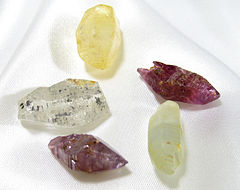
Back Korund AF Corindón AN كورندم Arabic Korund AZ Карунд BE Карунд BE-X-OLD Корунд Bulgarian Korund BS Corindó Catalan Korund Czech
| Corundum | |
|---|---|
 | |
| General | |
| Category | Oxide mineral – Hematite group |
| Formula (repeating unit) | Aluminium oxide, Al 2O 3 |
| Strunz classification | 04.CB.05 |
| Dana classification | 4.3.1.1 |
| Crystal symmetry | Trigonal (32/m) |
| Unit cell | a = 4.75 Å, c = 12.982 Å; Z=6 |
| Identification | |
| Color | Colorless, gray, brown; pink to red, orange, yellow, green, blue, violet; may be color zoned, asteriated mainly grey and brown |
| Crystal habit | Steep bipyramidal, tabular, prismatic, rhombohedral crystals, massive or granular |
| Crystal system | Trigonal (Hexagonal Scalenohedral) Symbol (32/m) Space group: R3c |
| Twinning | Polysynthetic twinning common |
| Cleavage | None – parting in 3 directions |
| Fracture | Conchoidal to uneven |
| Tenacity | Brittle |
| Mohs scale hardness | 9 (defining mineral)[1] |
| Luster | Adamantine to vitreous |
| Streak | White |
| Diaphaneity | Transparent, translucent to opaque |
| Specific gravity | 3.95–4.10 |
| Optical properties | Uniaxial (–) |
| Refractive index | nω = 1.767–1.772 nε = 1.759–1.763 |
| Pleochroism | None |
| Melting point | 2044 °C |
| Fusibility | Infusible |
| Solubility | Insoluble |
| Alters to | May alter to mica on surfaces causing a decrease in hardness |
| Other characteristics | May fluoresce or phosphoresce under UV light |
| References | [2][3][4][5] |
| Major varieties | |
| Sapphire | Any color except red |
| Ruby | Red |
| Emery | Black granular corundum intimately mixed with magnetite, hematite, or hercynite |
Corundum is a mineral. It is very hard, with a Mohs hardness of 9 (diamond is 10). It is usually clear. Its chemical formula is aluminium oxide, Al2O3. Sometimes some of the aluminium atoms get replaced with chromium atoms. It then becomes a ruby. Other impurities can make a sapphire.
- ↑ "Mohs' scale of hardness". Collector's corner. Mineralogical Society of America. Retrieved 10 January 2014.
- ↑ Anthony, John W.; Bideaux, Richard A.; Bladh, Kenneth W. and Nichols, Monte C., ed. (1997). "Corundum". Handbook of Mineralogy (PDF). Vol. III(Halides, Hydroxides, Oxides). Chantilly, VA, US: Mineralogical Society of America. ISBN 0962209724.
{{cite book}}: CS1 maint: multiple names: editors list (link) - ↑ Corundum. Mindat.org
- ↑ Corundum. Webmineral
- ↑ Hurlbut, Cornelius S.; Klein, Cornelis, 1985, Manual of Mineralogy, 20th ed., Wiley, pp. 300–302 ISBN 0-471-80580-7